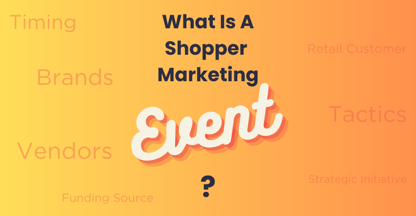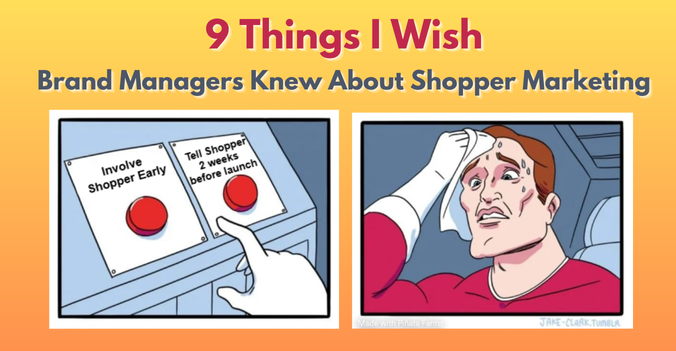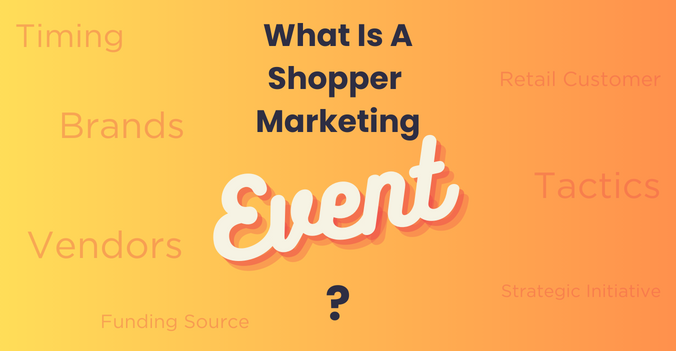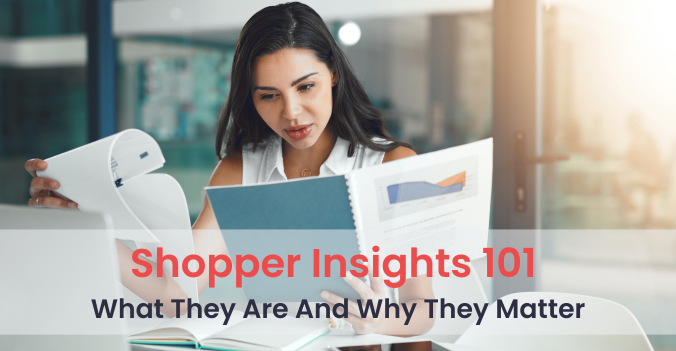
Omnichannel shopper marketing is a dynamic, constantly evolving discipline. It sits in between and overlaps with brand management, sales, e-commerce and media teams. This makes shopper marketing very diverse and full of nuances and gray areas.
A perfect illustration of this diversity and grayness is the fact that we have to always have a conversation with clients about the definition of a basic unit of activity, the shopper marketing event (a.k.a. program, or promotion). Establishing a clear definition and nomenclature is essential for process standardization and automation, so we always recommend documenting and formally communicating to the team what is meant by an “event” in the context of their particular organization.
Shopper Marketing Event Specs
Shopper marketing events are descrete amounts of marketing activity that are time-bound, strategic, and measurable.
What are the dimensions, or the “specs” of a shopper marketing event? Here are the key considerations:
- Timing - short-term or “always-on”?
- Retail Customers - is it a national or retailer-specific promotion?
- Brands - single-brand or a scale promotion?
- Tactics - single touchpoint or 360-degree activation?
- Vendors - executed by one or multiple vendors?
- Strategic Initiative - does it support a larger company or brand strategy or is it a one-off activation?
- Funding Source - is this event funded by one or multiple budgets?
- Spend Amount - is there a dollar amout that is too small for a stand-alone event? What is the size of an investmetn that is too large and must be broken out into components?
Examples of Shopper Marketing Events
Depending on how your team’s responsibilities are assigned, the way that events are defined can vary significantly. For instance, if your shopper marketing team is brand-facing, you are less likely to run scale promotions. If your team is retailer-facing, they are more likely to drive scale and support retailer-centric initiatives. Here are some examples of how events scoped, often within the same organization:
- Vendor-centric event: Neptune annual contract commitment for in-store signage across multiple retailers and brands;
- Tactic-centric event: Always-on search campaigns across multiple retailer.com platforms for a single brand;
- Season-centric event: A large, 2-week Back to School campaign that features many omnichannel tactics and a dozen or so brands plus a tie-in F&D support by the retailer;
- Occasion-centric event: Dinner Meal solutions promotion at one or more retail accounts featuring company’s own brand and complimentary products from other CPGs and private brands.
- Initiative-centric event: outside of seasons and occasions, brands may have other strategic priorities, such as cause marketing, sports marketing, ethnic marketing, or college campus marketing campaigns done in partnership with retail customers who have similar focus areas.
- Retail customer-centric event: A loyalty coupon mailer at Kroger is run 12 times a year with different brands’ offers featured in each mailer.
- Innovation-centric event: A Retail Media buy in support of a new product launch, consisting of a mix of on-site media, on-site search, and digital coupons.
- Budget-centric event: a combination of tactics that are all funded by a specific budget type.
- Opportunistic event: A one-off, tactical digital coupon offer intended to stock the pantries in anticipation of a competitor’s new product introduction at a single retail account.
Why Should I Bother Defining A Shopper Marketing Event?
It will never be possible to standardize all events to the same format, especially in large omnichannel shopper marketing organizations who now manage in-store, retail media, traditional and digital campaigns. However, attempting this task is important to develop best-in-class recommendations, drive process automation and better post-event analytics.
- Better reporting: When events are structured consistently, with meaningful naming conventions, at-scale, automated managerial reporting becomes possible. The management can get answers to most pressing questions without distracting the team and demanding manual reporting.
- Seamless actualization: When events are clearly defined, actualizing them is easier. The unique event IDs can be assigned and propagated throughout the financial systems, enabling payments and deductions to match individual event forecasts.
- Agile analytics: When events are consistently structured and actualized, on-going, automated and timely ROI analytics becomes possible. Until that happens, all post-event measurement activities will be a one-off, burdensome and unsustainable.
Interested in tackling event definition for your organization? Let us know if we can help. Schedule a free consultation with Shopperations.
Other Posts You May Like:
WHY MANAGING COUPON SPEND SHOULD BE SHOPPER MARKETERS’ STRATEGIC PRIORITY
HOW TO CALCULATE SHOPPER MARKETING ROI
8 features of a great Shopper Marketing Plan









